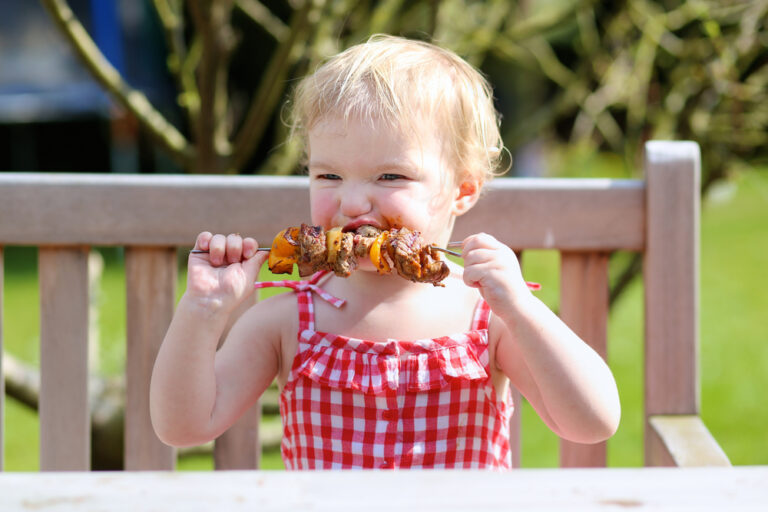Meat is usually not the first food on most parent’s minds when it comes to feeding their baby, but babies can actually eat meat as soon as they start eating other solid foods around 6 months old. Meat is a great food for babies because it provides important nutrients such as iron and zinc. Iron is one of the most important nutrients for babies to receive.
Readiness Signs
Before a baby can start eating meat, they should be meeting all of the readiness signs for eating. This includes:
- Sitting up with very little or no support
- Good head control
- Showing an interest in food
- Grabbing objects/toys and bringing them to the mouth
Many babies show these signs right around 6 months of age, which is the suggested time to start feeding solids.
How to Serve Meat
At 6 months old, there are a few different approaches you can take to feeding your baby. You can take the traditional approach of spoon-feeding purees or you can try out what is referred to as baby-led weaning. You can also do a combination of both.
Spoon-feeding/Purees
Spoon-feeding purees is when you either buy or make pureed baby food and put the spoonful of pureed food in the baby’s mouth. Meat does not naturally come pureed, so if you choose this approach you will either need to buy or make pureed meat to feed your baby. Making pureed meat is not an easy task, so you may want to stick to store-bought if you are choosing to do purees. If you do want to make your own, check out the best blenders for making baby food.
Purees can be a good choice for babies new to eating from 6-9 months, but by 9 months babies should be starting to eat regular food and start to feed themselves.
Baby-led Weaning/Self Feeding
Baby-led weaning is when you allow your baby to feed themself. You can do this by offering a loaded fork or spoon with puree or soft food on it, or you can serve food in soft strips and allow your baby to pick up the strip on their own and bring it to their mouth to chew on.
When starting out with meat in baby-led weaning, offering a strip of some really soft chicken is a great way to introduce meat. Even if your baby just sucks on it and doesn’t swallow, they are still getting some of the nutrients from the meat juices.
Baby-led weaning is a perfectly safe way to feed your child, but make sure to do some research beforehand on how to serve the foods to prevent choking. Meat can be a choking hazard so it is important to learn how to serve it correctly.
Ideas for Serving Meat
Chicken
- Rotisserie Chicken
- This chicken usually tends to be very soft and can be easily taken off in strips from the bones. Just make sure to check if the meat was cooked with honey (no honey before 1).
- Slow Cooker Chicken
- Making chicken in a slow cooker is a great way to ensure that your chicken will be soft and easily made into strips. If you plan on pureeing your chicken, a slow cooker is a good way to start as well because of how soft it gets.
- Bite-sized Soft Chicken Breast
- You can also cook chicken breast and cut it into bite-sized pieces, as long as the breast is soft. This means you should be able to squish it with your thumb and index finger.
- If your child is older and has a pincher grasp, they may be able to pick up the pieces on their own. If they are not, you can serve it loaded on a fork and they can bring the fork to their mouth.
- When serving this way, make sure your child has had some experience with chewing bite-sized pieces of food in the past
- Chicken Nuggets
- A great quick option that is usually served in easy-to-pick-up sizes. The breading may make it tastier for your child. They usually come soft, but check for softness before serving.
Beef
- Ground beef
- Ground beef is the best option for beef for babies because it is soft and tender. If your baby can pick up small pieces, they can pick up small pieces of ground beef on their own. If they cannot, you can load small pieces on a fork. Ground beef with a mild taco seasoning is a good choice to serve.
- Hamburger
- You can also serve ground beef as a hamburger patty. Cutting the patty into strips makes a good size for a baby to pick up and feed to themselves.
- Meatballs
- Serving ground beef as a meatball is another great option for babies. Babies can grab the meatball and take bites of it if it is large enough.
- Tender sliced beef
- You can serve strips or bite-sized pieces of beef if it is very tender and soft. Beef such as brisket can be a good option for babies.
- Steak is not a great food for a baby because of how hard it can be to chew. This makes it a choking hazard. But, if your baby has no teeth or you are confident they will not be able to bite off a piece of it, you can serve them a strip of steak to suck on. The juices from a piece of steak are an excellent source of iron.
Other Meats
- Turkey
- Sliced turkey from the bone can be another great meat option for babies because of its tenderness.
- Ground turkey can be served in the same way as ground beef.
- Deli turkey or cold cuts are not suggested for babies because of their salt content and nitrates.
- Pork
- Ground pork can be served the same way as ground beef, just make sure to check for tenderness.
FAQs – Serving Meat to Babies
Is meat a choking hazard for babies?
It can be, and that is why it is important to make sure it is cooked and served correctly. For the youngest babies without chewing experience, make sure the meat is as tender as can be. It should be able to be squished between your fingers. Tough meat, and whole or round slices of hot dogs or sausages are choking hazards until age 2 (some say even age 4). Until then, hot dogs and sausages can be served by being cut into halves or fourths but are more appropriate for babies over 12 months.
Can I use seasonings on the meat that I serve my baby?
Yes, you can use seasonings, but be avoid too much salt. Salt intake should be limited for babies under 12 months. If your baby is a newer eater or has never tried meat before, you may want to start with a very mild seasoning as to not overwhelm them.
Can my baby be allergic to meat?
Meat is not a common allergen, but many pediatricians do recommend serving one food at a time to babies starting out with eating. So the first time you serve meat, serve it on its own or with something you already know your baby does not react to. This way, if your baby has a reaction, you can know easier what the reaction was from. It is important that you do not serve meat along with the top common allergens (dairy, eggs, nuts, soy, fish, and wheat) until you have already served these common allergens and ruled out reactions.
Does my baby have to eat meat?
No, it is never necessary to serve meat to your baby. Although it is a great source of important nutrients, you can wait until your baby is older than 6 months to serve it if that makes you feel more comfortable. You can also never serve it at all if you are choosing to keep them on a vegetarian diet. Just make sure to serve other sources of protein and iron.
What if my baby does not like meat?
It is totally normal for your baby to not like eating meat. It is a very different taste from fruits and vegetables and it can take some getting used to. Just because your baby does not like it, does not mean you shouldn’t serve it. Keep offering and one day they may decide to try. You can also offer it with a dip such as ranch or ketchup.
Wrap Up
Feeding your baby their first foods is an exciting change in both of your lives but can be very overwhelming as well. Luckily we have lots of information about how and when to serve foods such as peanut butter, strawberries, and cheerios to your baby.
When it comes to meat remember:
- Babies can eat meat as soon as 6 months when other solid food is started.
- Serve on a spoon as a puree.
- Offer in strips or small bite sizes pieces on a fork for baby-led weaning.
- Needs to be very soft and tender for the baby to chew.
- Start with mild seasonings on the meat.
- Serve away from other allergens if just starting out.
- If your baby doesn’t like meat, just keep offering or offer a dip along with it!






